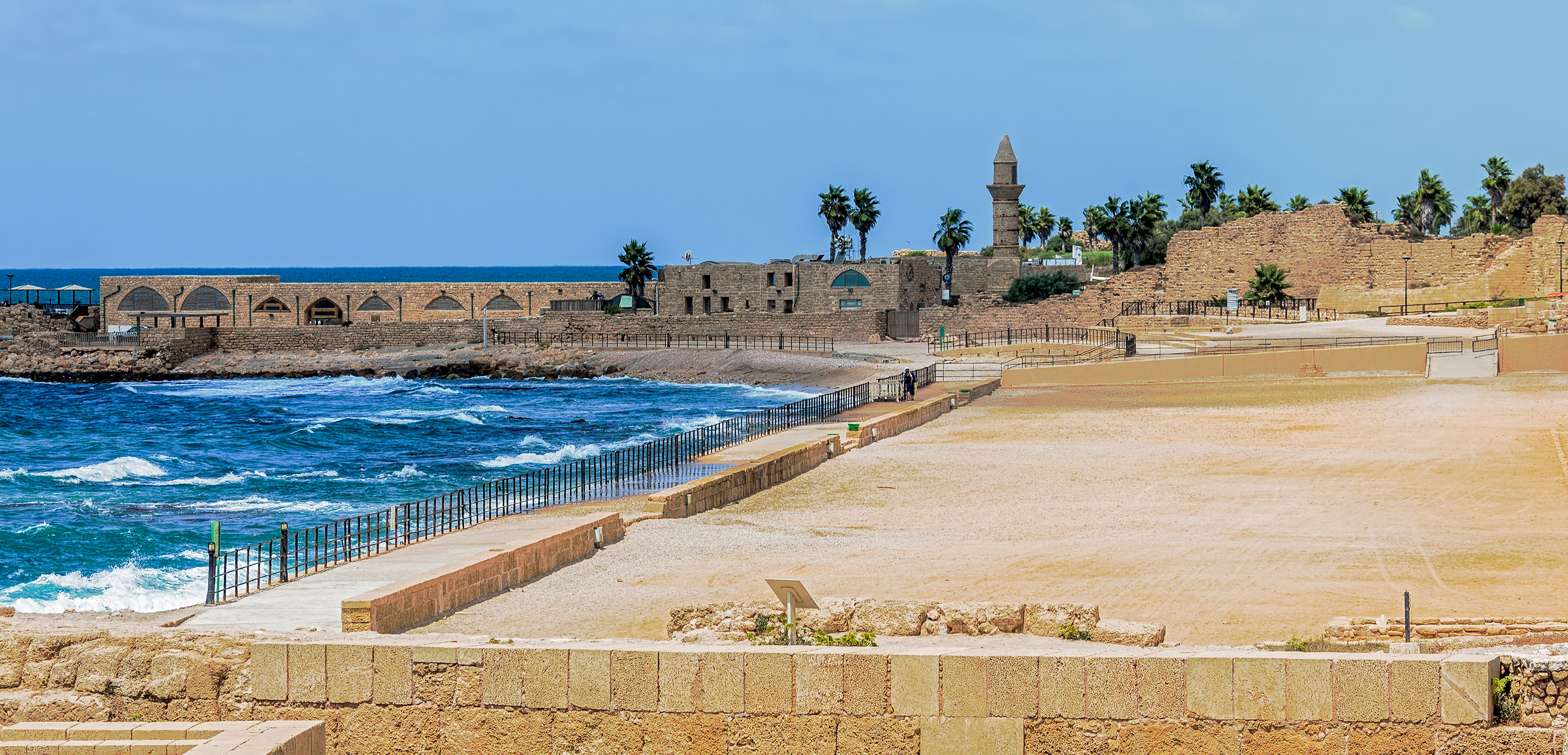
Israel is a country rich in history, where ancient civilizations, significant religious landmarks, and archaeological wonders are scattered across its landscape. While Jerusalem often takes the spotlight, there are many other regions that offer a treasure trove of historical and cultural insights. From the dramatic cliffs of Masada to the ancient ruins of Megiddo, these sites are essential for anyone interested in delving deeper into Israel’s past. Whether you’re considering an Israel tour package or looking for unique Israel day trips, these 20 famous archaeological sites provide a glimpse into the ancient world and the diverse cultures that once thrived here. Ideal for day tours from Tel Aviv or day tours from Jerusalem, these locations allow visitors to step back in time and explore the history that shaped the Holy Land.
Masada: Towering high above the Dead Sea, Masada bears witness to one of the most dramatic events in Jewish history. Built by King Herod the Great around 30 BCE, this natural fortress became a symbol of Jewish resistance during the tragic siege of 73-74 CE. Excavations led by Israeli archaeologist Yigael Yadin in the 1960s uncovered a wealth of artifacts and structures, shedding light on daily life in the fortress and the events leading up to its fall. Many Israel tour packages include this iconic site for those wanting to experience Israel's ancient history.
Megiddo: Dubbed "Armageddon" in Christian tradition, Megiddo's strategic location made it a coveted prize throughout history. Excavations by renowned archaeologists such as Gottlieb Schumacher and Yigael Yadin have uncovered over 20 layers of civilization, revealing insights into urban planning, warfare, and religious practices spanning millennia. The site's rich history includes conquests by the Egyptians, Canaanites, Israelites, and Assyrians.
Beit She'an: As one of the oldest continuously inhabited cities in the region, Beit She'an has a rich history dating back to the Chalcolithic period. Its Roman and Byzantine ruins offer a glimpse into daily life during the classical era. Excavations conducted by the Hebrew University of Jerusalem and the Israel Antiquities Authority have revealed a well-preserved theater, bathhouses, and colonnaded streets, providing valuable insights into urban planning and civic life. Israel tour packages frequently include Beit She'an as part of a tour through the ancient cities of Israel.
Caesarea: Built by Herod the Great in the 1st century BCE, Caesarea served as the Roman capital of Judea. Its well-preserved ruins include a massive amphitheater and aqueducts, reflecting its importance as a center of trade and culture. Excavations led by archaeologists such as Robert J. Bull and Joseph Patrich have uncovered evidence of Roman, Byzantine, and Crusader occupation, revealing the city's vibrant history as a cosmopolitan hub. Day tours from Tel Aviv often feature Caesarea due to its significance throughout history.
Gan Hashlosha National Park (Sachne): This park's natural springs have drawn human settlement for thousands of years, evidenced by ancient agriculture traces. Excavations conducted by the Israel Antiquities Authority have uncovered ancient terraces, irrigation channels, and agricultural installations, providing insights into agricultural practices and land management in antiquity.
Gamla Nature Reserve: Known as the “Masada of the North”, Gamla's rugged cliffs and strategic location made it a stronghold during the Jewish Revolt against Rome in the 1st century CE. Excavations led by Israeli archaeologists Shmarya Gutmann and Yitzhak Magen uncovered evidence of ancient Jewish life, including a synagogue, dwellings, and defensive fortifications. The site's discovery in the 1960s sparked renewed interest in the study of ancient Jewish settlements in the Galilee and Golan regions.
Qumran National Park: The discovery of the Dead Sea Scrolls near Qumran in 1947 was a pivotal moment in biblical archaeology, revealing a treasure trove of ancient manuscripts dating from the 2nd century BCE to the 1st century CE. These scrolls, hidden in earthen jars within caves, include biblical texts, sectarian writings, and community rules, offering invaluable insights into Judaism during the Second Temple period and the origins of Christianity. Beyond biblical texts, the Dead Sea Scrolls shed light on the diverse religious beliefs and practices of Jewish communities, particularly the Essenes who likely inhabited the nearby settlement of Qumran. The scrolls also spark debate about the possible connections between these Jewish sects and early Christianity. Excavations at Qumran have uncovered the remains of a settlement, providing archaeological context for the discovery of the scrolls and deepening our understanding of ancient Jewish life in the region.
Ein Gedi National Park: This oasis has attracted settlers since antiquity due to its abundant freshwater springs and lush vegetation, mentioned in the Hebrew Bible as a refuge for David while fleeing from King Saul. Excavations conducted by Israeli archaeologists such as Ehud Netzer have uncovered evidence of ancient settlements dating back to the Iron Age and later, showcasing a Jewish synagogue with a mosaic floor telling us about a unique secret of the town.
Timna: Mining operations in Timna date back over 6,000 years, making it one of the oldest copper production sites in the world. Excavations led by Israeli archaeologists such as Beno Rothenberg and Erez Ben-Yosef have uncovered evidence of ancient mining shafts, smelting furnaces, and rock carvings, revealing insights into ancient metallurgy and trade networks in the region.
Makhtesh Ramon (Ramon Crater): Despite its name, Makhtesh Ramon is not an impact crater but rather a geological formation unique to the Negev Desert, with archaeological finds including prehistoric campsites and Byzantine farms. Excavations led by Israeli archaeologists such as Avraham Eitan and Uzi Avner uncovered evidence of ancient human occupation, including flint tools, pottery fragments, and animal bones, providing insights into ancient desert life.
Hula Valley Nature Reserve: Once a malaria-infested swamp, the Hula Valley has been restored to its former glory as a haven for migratory birds, with archaeological excavations revealing evidence of human settlement dating back to the Stone Age. Excavations led by Israeli archaeologists such as Moshe Dothan and Yosef Garfinkel have uncovered artifacts and structures, including pottery vessels, stone tools, and burial sites, shedding light on ancient agricultural practices and social organization.
Ein Hemed National Park: Originally built by the Crusaders in the 12th century, Ein Hemed's picturesque setting features a charming monastery surrounded by lush gardens and bubbling springs. Excavations conducted by Israeli archaeologists such as Yoram Tsafrir and Yizhar Hirschfeld have uncovered evidence of medieval occupation, including architectural remains, pottery fragments, and religious artifacts, providing insights into Crusader-era life in the Holy Land.
Nahal Me'arot Nature Reserve: A UNESCO World Heritage Site known for its prehistoric caves and archaeological significance, Nahal Me'arot's caves have yielded evidence of human occupation spanning over 500,000 years, shedding light on early human evolution and behavior. Excavations led by Israeli archaeologists such as Dorothy Garrod and Ofer Bar-Yosef have uncovered stone tools, hearths, and animal bones, providing insights into ancient hunting and gathering societies.
Shivta National Park: Founded by the Nabateans in the 1st century BCE, Shivta was a thriving agricultural settlement on the ancient Incense Route. Its well-preserved ruins offer insights into Nabatean culture and urban planning. Excavations led by Israeli archaeologists such as Michael Avi-Yonah and Rudolf Cohen have uncovered evidence of ancient streets, houses, churches, and cisterns, providing insights into daily life in the desert.
Montfort Castle National Park: Built by the Crusaders in the 12th century, Montfort Castle served as a strategic stronghold in the Galilee Highlands, revealing insights into medieval military architecture and life. Excavations led by Israeli archaeologists such as Adrian Boas and Rabei Khamisy have uncovered evidence of medieval occupation, including defensive walls, residential quarters, and a massive keep, providing insights into Crusader-era fortifications and social organization.
Nimrod's Fortress (Kalat Nimrod) National Park: Originally built by the Ayyubids in the 13th century, Nimrod's Fortress offers panoramic views of the surrounding landscape, inviting visitors to imagine the battles and sieges that once took place here. Excavations led by Israeli archaeologists such as Yoram Tsafrir and Haim Avni have uncovered evidence of medieval occupation, including towers, gates, and residential quarters, providing insights into military architecture and daily life in the Middle Ages.
Banias Nature Reserve: Nestled at the foot of Mount Hermon, Banias is a picturesque nature reserve with hiking trails, waterfalls, and ancient ruins, including a temple dedicated to the god Pan. This site holds historical and religious significance as the location of Caesarea Philippi, where Jesus entrusted Peter with the keys to the kingdom of heaven, marking a pivotal moment in Christian tradition. Excavations led by Israeli archaeologists such as Avraham Biran and Yigal Yisrael have uncovered evidence of ancient settlements dating back to the Hellenistic and Roman periods, including houses, public buildings, and religious structures. These findings provide insights into urban life, religious practices, and the historical context of this remarkable site.
Beit Alfa Synagogue National Park: Dating back to the Byzantine period, the Beit Alfa Synagogue boasts exquisite mosaic floors depicting biblical scenes and geometric motifs, highlighting the rich cultural heritage of ancient Jewish art. Excavations conducted by Israeli archaeologists such as Yoram Tsafrir and Tsvika Tsuk have uncovered evidence of a thriving Jewish community, including a synagogue, ritual baths, and residential quarters, providing insights into Jewish religious life and artistic expression in Late Antiquity.
Tel Hatzor: Tel Hatzor is one of the largest and most important archaeological sites in Israel, with evidence of continuous settlement from the Bronze Age to the Iron Age. Excavations led by Israeli archaeologists such as Yigael Yadin and Amnon Ben-Tor have uncovered a Canaanite palace, ancient city gates, and a massive water system, shedding light on the region's political and economic significance.
Tel Aviv-Jaffa: This ancient port city, known for its vibrant history and cultural significance, boasts a fascinating blend of ancient ruins and modern urban development. Excavations conducted by Israeli archaeologists such as Robert Biran and Raphael Greenberg have uncovered evidence of Jaffa's significance as a trade hub throughout history, with artifacts from ancient Egyptian, Canaanite, and Philistine civilizations offering insights into the city's role in regional trade and politics.
These archaeological sites offer a fascinating glimpse into Israel's rich history, spanning thousands of years and encompassing diverse civilizations and cultures. Whether exploring ancient ruins, deciphering inscriptions, or marveling at intricate mosaics, visitors are sure to be captivated by the stories etched in stone across the Holy Land.
Explore tours by category



